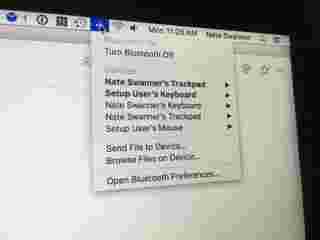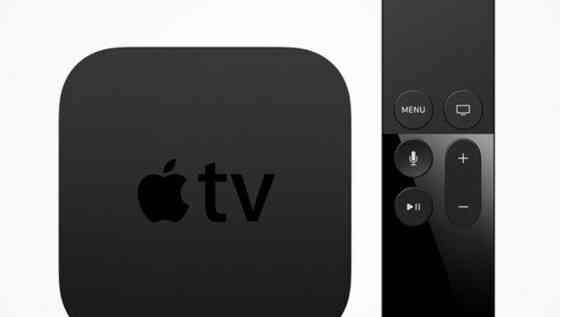It has 4K, Force Touch and lots of folks talking. The new 21.5-inch iMac from Apple brings a lot to the table, but is it worth your $1,099 (or more)? Lets find out.

In many ways, not much has changed with regard to design. It’s still a screen sitting atop a pedestal, and Apple didn’t pull any punches by stripping it of ports. The iMac is still slim, sexy and iconic.
As desktops go, an iMac will provide all you need. The big, beautiful screen has a very adequate 720p FaceTime webcam, and there are dual speakers just under the front panel.
You also get a 3.5mm headphone jack, SD card slot, four USB 3 ports, two Thunderbolt ports and a gigabit ethernet port. Aside from the power cable input and power button, the rear is very plain.
I’ve openly questioned 4K’s purpose when it comes to mobile devices, but not the desktop. It’d be really easy to consider Apple late to the 4K game, but there’s a trick up iMac’s sleeve: P3.
So here’s where we get geeky. P3 brings a wider color gamut to the Retina 4K screen, and outpaces the sRGB that is fairly standard by up to 25 percent.
So what does that mean for you? As you can see in the charts below, that funny color space is what the naked eye is capable of seeing while the dotted line represents what sRGB displays. P3– the solid line — allows the screen to display more blues, greens and reds than many screens. It doesn’t mean you’ll see colors you’ve never seen before, only that the picture you see via the Retina 4K iMac is more accurate to real life.
The change is subtle, and sadly I can’t prove it to you via an article. But once you see it for yourself, the benefit becomes apparent. It’s as if your current monitor or computer is lying to you.
Blues and greens are deeper, reds look red , and those in-between colors like orange look brilliant. If you like yellow, you’ll love the Retina 4K iMac.
The screen resolution is 4096 x 2304.
I thought it might be, but no — it’s not. Apple achieved P3 by increasing the pixel density (4K, duh) and changing the LEDs.
Instead of a white LED, the iMac Retina 4K uses a red-green phosphor LED. It explains the chart above, too; reds and greens jump 25 percent on that chart, while blue is basically even to sRGB monitors. The second set of graphs illustrate that nicely.
Casual users will like it, and if you work in visual arts — you’ll love it. P3 is ahead of the curve, but it’s impressive.
With your iMac, you’ll get a few refreshed input devices: the new keyboard and mouse, and an optional trackpad.
The Magic Keyboard is somewhere between a new MacBook and legacy Apple keyboard. It’s not quite as flat and responsive as the MacBook’s, which is because Apple didn’t implement its new butterfly mechanism. Instead, it reworked the scissor mechanism to be flatter. That helps it sit lower to the table, too.
Apple says it provides 33 percent more key stability, which is noticeable. Function keys are also full-size.
Magic Mouse 2 has new rails underneath that provide a smoother gliding experience, and is much lighter than its predecessor. It’s got a multi-touch surface, too, so you can scroll and such without the need for a wheel.
Magic Trackpad 2 is much sleeker, and brings in Force Touch. Apple also increased the surface area by 29 percent.
All three have rechargeable lithium ion batteries. The trackpad and keyboard work when plugged in — the charging port is around back — while the Magic Mouse needs to be idle while charging (it’s port is underneath).
The mouse will get you through the day with a two-minute charge, Apple says. Though the mouse was the only device officially tested to provide that feature, similar results can be found with the keyboard and trackpad.
Each new iMac has Apple’s Fusion Drive, which cleverly adds a small bit of Flash memory to a spinning drive. The aim is to let the Flash drive keep apps you use frequently on a flash drive, while others wait in the hard drive.
In theory, Fusion Drive will make using core apps you rely on daily a snappier experience. Power users will likely want to upgrade to a 2TB Fusion Drive, which can bring more flash storage.
So, here’s the thing with newer Apple hardware: you won’t be able to upgrade it later on.
Perhaps the most glaring issue will be the inability to replace the Fusion Drive with an SSD if you don’t like what Apple has to offer. Apple also moved away from a discrete graphics card with the iMac Retina 4K, which like the Fusion Drive is probably just fine for most of us.
In that vein, you won’t be able to push the iMac beyond what Apple designed it to do. You aren’t going to slip a badass graphics card in there, or crack it open to upgrade your RAM. It is what it is, so build yourself a good one upfront.
You can order the iMac to suit your needs, but here are the main specs for the model I tested:
For those who are a bit more casual with their needs, the 21.5-inch iMac is a fantastic computer. Aside from being gorgeous, the new input devices are a significant improvement over the older stuff. The trackpad in particular is a breath of fresh air.
Force Touch and 3D Touch are the future, and it’s really nice to have it on the desktop. I’m sure it’ll hit the Magic Mouse someday, but that probably depends on Apple figuring out Force Touch for curved surfaces. Including Force Touch on the trackpad was a brilliant move.
The Magic Keyboard is much nicer to type on, too. It’s also flatter to my desk, which I prefer.
I did have a few letdowns early on with the iMac, which appear to have come from nowhere. At one point, the trackpad was dropping and picking up its Bluetooth connection without anything having changed. I also have some issues with AirDrop, another Bluetooth feature.


Apple has had some issues with Bluetooth in the past, which were fixed with a software update. The keyboard and trackpad issues were one-off, so I’m not that concerned it’ll be an ongoing headache.
There were also a few times the iMac was just too slow; growing pains that seemed to ease over time. After about five days of use, the issues ironed themselves out.
The Fusion Drive is fine for core apps you use daily, but firing up an app on your fringe isn’t so fast. There was never an “oh, come on!” moment, but it just wasn’t as snappy as my MacBook Pro.
For instance, I use Pixelmator often, but not daily. It takes a few more seconds (literally) to load on the iMac than it does on my MacBook. Not a deal breaker by any stretch, and likely only noticeable because I have a different experience elsewhere.
The 4K Retina screen is phenomenal. P3 is not something you’ll notice every day, but reverting to the LG monitor I used before the iMac was a letdown — and I thought that was a very decent monitor. It even makes my MacBooks look grainy, and they’re both Retina.
The sound from the speakers is a bit hollow, but loud enough for just about any use case. If you’re catching a YouTube video, there won’t be an issue. If you’re streaming classical music, you’ll probably want some external speakers.
Apple’s 21.5-inch iMac is the little brother of the iMac lineup. Most people will probably enjoy the 21.5-inch footprint, and the 4K screen is so brilliant you won’t notice if it’s a touch smaller than your current display.
If you’ve got a new iPhone 6s or 6s Plus or are planning to buy an iPhone 7 — and are also in the market for a desktop computer — you should definitely check the iMac Retina 4K out. I especially like it for editing 4K movies shot on my iPhone 6s Plus in iMovie (which has also been updated to support 4K). If you need a workhorse for the home or office, you won’t be let down.
For most users, this will be a great purchase. I’ve done everything from edit simple 4K movies to compile simple apps without any problems. The iMac also handles several apps and desktops with relative ease.
The basic Fusion Drive is a bit limited if you’ve got a lot (say, 10 or more) of apps you like to bounce between routinely. The Intel Broadwell chipset is fine, but a lack of discrete graphics means it’s a package deal. Again, upgrade at purchase time if you even think you’ll need more oomph.
The new keyboard, mouse and trackpad are all great. I don’t like to use a mouse, and the Magic Mouse isn’t very ergonomically sound, but each was a joy to use. Again, Force Touch on the desktop is just awesome.
The real star remains the screen. Once you actually experience 4K and P3, it’s hard to revert. For its minor failings, the iMac is still a winner because of that 4K, P3 display.
Apple’s 4K iMac is available direct from Apple, and starts at $1,099.
Sphero’s BB-8 is the ultimate Star Wars droid
In the world of the upcoming Star Wars movie, ‘Star Wars: The Force Awakens,’ there is perhaps nothing I am more excited about than BB-8. When the little orange droid wheeled itself onstage during the Star Wars Celebration earlier this year , you could feel the palpable excitement emanating from the crowd. He was cute, he was expressive and he was shaped in a little whimsical figure-eight.

“Would you like to hold BB-8?”
The question seemed odd. I’d spent the last 10 minutes staring at the officially licensed BB-8 droid developed by robotics company Sphero . The droid, without any specific input to his controls, bleeped and blooped his way around a little table. He seemed precious, but I gingerly picked up the robot. I could feel his little gears working in the palm of my hand as he rotated his little head to “view” his surroundings.
“He’s like a puppy!” I squealed, but I couldn’t help myself. There’s just something about Sphero’s work in this robot that brings a piece of Star Wars to life in a way I’ve never before experienced.
In developing the officially licensed BB-8 droid, robotics company Sphero had a tall order to fill. Not only did the company have to live up to the rigorous expectations of franchise owner Disney and create a robot that embodied BB-8’s canonical personality (One that Sphero helped create for the life-size BB-8 seen in the movie), it also set some lofty goals for itself.
Particularly, that BB-8 becomes the consumer entry into the world of robotics, as an autonomous and ubiquitous companion that grasps at the future of what we could have (and what Star Wars promises us).
Of course, that goal is somewhat limited by the reality of modern robotics. The idea of a companion robot implies that it has an autonomous sensibility and the drive to do things for itself. While scientists are on the forefront of teaching robots the finite aspects of human language and directions, we’re far from developing a robot that will create and manage its own actions. But that doesn’t mean that Sphero isn’t trying to imbue its robots with that spark of autonomy — both its Sphero and Ollie models have distinct personalities and scenarios designed to get people of all ages interacting with them.
But BB-8 is different. He has a face.
And, perhaps unsurprisingly, that is where the droid’s magical “humanity” is found. BB-8 turns, looks, and emotes with simple gestures designed to evoke puppeteering rather than robotics. He’s not needy or craving attention a la the Furby, but he does make little noises to let you know that he’s there and he’s listening.
But the magic lies beyond how BB-8 looks and feels — it’s also what he can do.
The practical nuts and bolts of the commercial version of Star Wars’ latest droid were explicitly designed by Sphero to be durable. The droid is molded in a hard plastic that is designed to take the occasional collision without doing lasting damage, and his little head comes flying off if he hits a wall or sustains a sharp fall. The folks at Sphero told TNW that it has rarely received warranty calls related to unexpected damage to its robots, but they’re prepared to keep a stock of heads just in case.
BB-8 is prepared for damage, but he sure won’t like it. The first thing apparent when booting up a fresh BB-8 is that he is pre-programmed with strong opinions. Although he is essentially a ball with a little head, he communicates his feelings in finite ways when prompted by the Star Wars app (or when reacting autonomously).
BB-8, when prompted to agree with something, will lean over slightly to acknowledge your presence. When he is unable to perform a request or otherwise directed, he will swerve in a left-right motion to indicate disagreement or confusion. When he faces a non-threatening collision or detects an increase in speed consistent with a drop, he will let out a very surprised beep. And when he loses his head or is put in similarly unfavorable conditions, his body will turn red in anger.
The accompanying BB-8 app, which is available at launch for both Android and iOS (with Windows coming soon ), helps you articulate BB-8’s feelings and movement through tapping on feelings or voice input. For example, if you put BB-8 in ‘Listen’ mode and yell, “It’s a trap!” BB-8 will zoom away quickly (at a top speed of five miles per hour) in a panicked-appearing escape.
He also exhibits spontaneous movement and sounds, whether he is directly controlled via the app or in the autonomous “Search mode,” where the droid will simply bug off and explore his surroundings on his own. It certainly helps contribute to the magic of BB-8, allowing users to fill in their own imaginations and suspend their disbelief.
BB-8 also comes with an AR feature, creating the famous holograms from Star Wars with the app. Users can record their videos and then “project” them onto BB-8, which is a fun little novelty.
Practically, though, BB-8 is available in relatively short bursts. His battery life is roughly 60 minutes, so he’ll have to go back to his wireless charging station quite a few times if you’re keen on all-day play. But Sphero’s promised frequent update schedule means that BB-8 will continue to pick up new tricks over time.
I’ll be honest: it’s hard not to love BB-8. He’s adorable, he’s whimsical, and he’s a design-worthy successor to the other droid of everyone’s hearts, R2-D2 (Sorry, C-3PO, but you were outmatched). The miniature consumer version of him is packed with the same personality that will likely steal the scene in ‘The Force Awakens’ more than once.
But is he worth the retail price of $150?
That depends on a lot of factors, particularly your love for the Star Wars franchise and also how quickly you tear up in the sight of cute little androids. In my interactions with BB-8, I found myself suspending my disbelief in his presence. I wanted him very much to be real, and actually be sassy with me. I expect he’ll be a real charmer around young children, who will likely awe in his presence if he rolls his way into the home.
What is more exciting to me is whether Sphero can deliver on its promise of bringing a consumer companion robot that evolves thoughtfully and can eventually become autonomous. The company spoke vaguely of the updates that will come to BB-8 in the near future: particularly programmability, which will allow users to construct full routines for BB-8 to do by himself. But I’m looking forward to seeing whether different BB-8 droids differ in personality when they’re next to each other, whether the droids can talk amongst themselves, or whether BB-8 will be able to immediately respond to environmental actions like the sudden playing of music.
The more the company commits to updating BB-8 and showing off the latest tricks the robot can do, the less likely that it will gather dust in his docking station.
BB-8 is available Friday for $150 via Sphero’s approved retailers , including Amazon, Best Buy, and Disney stores.
Win a new 64GB Apple TV!
The long-awaited 4th generation Apple TV is finally available, and TNW Deals is hooking readers up with a chance to win one without spending a dime!

Apple announced the future of TV at its live event own September, promising to revolutionize TV by introducing apps and a new interface that blows everything else away.
When you win the 64GB Apple TV, you’ll have access to tons of great HD content in a tiny package. Enjoy blockbuster movies, TV shows, live sports and news, your music, photos, and more – and even play content from your iOS devices or Mac on your TV using AirPlay.
Siri Remote with Touch surface searches your apps for you, as you choose from thousands of viewing options from Netflix, Hulu Plus, YouTube, HBO, SHOWTIME, WatchESPN, and more. The sheer amount of games and apps available is staggering!
Winning is simple – just head to the contest page and fill out the online entry form with your valid email address, and you’re automatically entered. Share the giveaway on Twitter, and once you get some friends to enter, you’ll receive additional entries to win. One registration per person please!
➤ Get this deal
